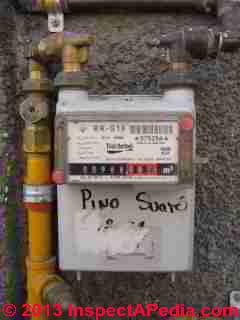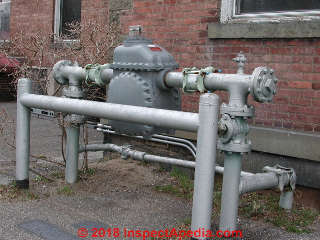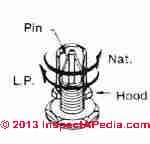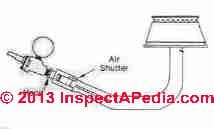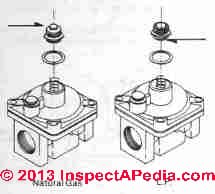 LP Gas & Natural Gas Controls, Tanks, Regulators & Piping
LP Gas & Natural Gas Controls, Tanks, Regulators & Piping
Home Page & Article Index
- POST a QUESTION or COMMENT about inspecting, testing, diagnosing, and repairing gas piping, gas regulators, and gas storage tank defects used with LP or natural gas burning appliances
LP & natural gas piping installation, inspection, testing & repair; gas controls, gas regulators & LP gas tank defects home page and index to key articles.
In this article series we provide descriptions and photographs how to select, install, diagnose or repair leaks or operating problems in fuel gas piping, regulators, or controls used on gas fired appliances or heating equipment, addressing both natural gas and LP gas equipment.
In this article we also discuss the procedure for converting from LP gas or "bottled gas" to natural gas or "piped in gas" at a building.
InspectAPedia tolerates no conflicts of interest. We have no relationship with advertisers, products, or services discussed at this website.
- Daniel Friedman, Publisher/Editor/Author - See WHO ARE WE?
Fuel Gas Controls, Valves & Piping
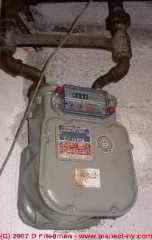 Beginning here with help in identifying the type of fuel gas supplied at a building: natural gas vs. LPG or propane, this article series describes the selection, installation, troubleshooting & repair of various types of fuel gas controls, gas meters, gas valves, gas piping and gas-fired appliances.
Beginning here with help in identifying the type of fuel gas supplied at a building: natural gas vs. LPG or propane, this article series describes the selection, installation, troubleshooting & repair of various types of fuel gas controls, gas meters, gas valves, gas piping and gas-fired appliances.
How to Identify the Type of LP Gas or Natural Gas Fuel Source
Immediate LP or natural gas safety hazards: if there is evidence of an LP or natural gas leak at a building, gas odors, for example, you should:
- Do not do anything that is likely to cause a gas explosion, such as lighting a match, operating an electrical switch, or even using a telephone in the building
- Leave the building immediately and keep a safe distance away - 100 feet or more.
- Notify other building occupants of the safety concern
- Contact the local gas company and/or fire department
More details about LP or natural gas immediate safety actions and hazards are
at GAS LP & NATURAL GAS SAFETY HAZARDS.
Our photo at left shows a gas meter installed indoors in a building utility basement. This will be a natural gas installation in which fuel gas is delivered to the building by a municipal gas supply system.
How to Recognize Piped in Natural Gas Supply at a Property
Natural gas is supplied by the utility company through piping, usually buried in the street in front of or behind the building, and entering the building through a gas meter which is located outside or at older installations, possibly inside the building.
Above right you will recognize yellow piped-in natural gas supply piping connected to a digital gas meter located on a building in central Mexico.
Below is a large gas meter and regulator installation at a New York facility.
How to recognize LP gas or Bottled Gas Supply at a Property or Building
LP Gas or "bottled gas" or liquid propane gas is supplied (usually) by a local LP gas distributor who fills an LP gas tank located on and serving the building.
The LP gas tank may be above ground (usually at a building exterior wall) or it may be buried at the property. Below at right we show a large LP gas tank or "bottled gas" serving a community of homes.
Natural gas and LP gas appliance compatibility
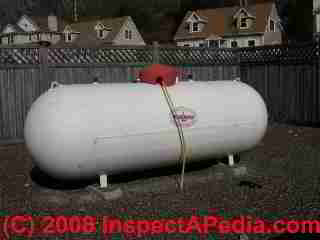 These two fuels are similar in that both are used to provide energy to home heating systems and other appliances but they have some different properties of operating gas pressure, weight, method of distribution, and chemistry.
These two fuels are similar in that both are used to provide energy to home heating systems and other appliances but they have some different properties of operating gas pressure, weight, method of distribution, and chemistry.
Most gas appliances are delivered already set up to use either natural gas or LP gas but not both without having to make some device adjustments or parts changes.
Most gas appliances can be converted from one fuel to the other - what is involved may be simply changing gas metering orifices in the equipment (for example at the burners on a stove) or it may also be necessary to change or adjust a gas regulator located inside the appliance.
Watch out: Do not hook up an LP gas-ready appliance to a natural gas supply nor can you connect a natural-gas ready appliance to an LP gas supply without reviewing and acting on the manufacturer's instructions for converting the appliance from one fuel to the other.
It is virtually always the case that some equipment adjustments and changes are necessary to switch between natural gas and propane gas.
As JR, an industry manager familiar with gas pressures pointed out, these two fuel gases operate at different pressures. In residential appliances
- Natural Gas system pressure: Natural gas operates at a nominal pressure of 7” WC (about 0.253 psi)
- LPG or Liquid Propane Gas system pressure: LP gas or propane operates at a nominal pressure of 11” WC (about 0.397 psi)
- Actual NG or LPG gas pressures vary: [Note: the exact pressure you see in the building at an appliance may vary from these numbers depending on the gas distribution piping system size, diameter, number of appliances served, number of appliances operating, regulator adjustment, and other factors.
See GAS REGULATORS & APPLIANCE / HEATER CONTROLS
and GAS REGULATORS for LP TANKS and LP or NATURAL GAS PRESSURES for a table showing the range of variation in LP gas pressure in the tank at various temperatures. - Ed.]
Typically the conversion between fuels requires simply the rotation, inversion, or adjustment of parts already present on the gas appliance.
Gas Regulator Conversion Step 1 Above: an oven burner control internal part is rotated to convert between LP or Natural gas
Gas Regulator Conversion Step 2 Below: the stove top gas burner air shutter position is adjusted.
Gas Regulator Conversion Step 3 Below: a component inside the gas regulator is inverted.
[Click to enlarge any image]
Details on converting between natural gas & LP gas or bottled gas: if you are planning to convert from one gas fuel to another, such as from LP gas (bottled gas or liquid petroleum gas) to piped in natural gas, see our advice and safety warnings
at GAS APPLIANCE CONVERT LP-to-NATURAL GAS.
Gas Pilot Light Instructions
Gas-Air Ratio Regulators
- Hauck, RRG GAS-AIR RATIO REGULATORS INSTRUCTIONS [PDF] (1994) Hauck Manufacturing Co., PO Box 90, Lebanon PA 17042, Tel: 717 272 3051
...
Continue reading at FLEXIBLE GAS CONNECTOR INSTALL or select a topic from the closely-related articles below, or see the complete ARTICLE INDEX.
Or see GAS PIPING, VALVES, CONTROLS FAQs - questions & answers about residential gas piping posted originally at this page.
Or see these
Gas Piping & Regulator Articles
- GAS BURNER FLAME & NOISE DEFECTS
- GAS BURNER PILOT LIGHT PROCEDURE
- GAS IGNITER DIAGNOSIS & REPAIR
- GAS METERS - home
- GAS PIPING, VALVES, CONTROLS - home
- FLARE FITTINGS
- FLEXIBLE GAS CONNECTOR INSTALL
- GAS CONNECTOR for BBQ GRILL
- GAS PIPING CLOG REPAIR
- GAS PIPING CLEARANCES, CODES & DEFECTS
- GAS PIPING, FLEXIBLE CSST
- GAS PIPING SIZE & MATERIAL
- GAS LEAK DETECTION, LP / NG
- GAS PRESSURES LP vs NATURAL GAS
- GAS REGULATORS & APPLIANCE / HEATER CONTROLS - home, Natural Gas regulators & appliance regulators, NG & LP
- GAS REGULATORS for LP TANKS - home, LPG / Propane systems
- GAS REGULATOR CONVERSION NG-LP
- GAS WATER HEATER CONTROL VALVES - pilot light, gas valve, thermostat for temperature control
Suggested citation for this web page
GAS PIPING, VALVES, CONTROLS at InspectApedia.com - online encyclopedia of building & environmental inspection, testing, diagnosis, repair, & problem prevention advice.
Or see this
INDEX to RELATED ARTICLES: ARTICLE INDEX to GAS APPLIANCES, PIPING, CONTROLS
Or use the SEARCH BOX found below to Ask a Question or Search InspectApedia
Ask a Question or Search InspectApedia
Questions & answers or comments about inspecting, testing, diagnosing, and repairing gas piping, gas regulators, and gas storage tank defects used with LP or natural gas burning appliances
Try the search box just below, or if you prefer, post a question or comment in the Comments box below and we will respond promptly.
Search the InspectApedia website
Note: appearance of your Comment below may be delayed: if your comment contains an image, photograph, web link, or text that looks to the software as if it might be a web link, your posting will appear after it has been approved by a moderator. Apologies for the delay.
Only one image can be added per comment but you can post as many comments, and therefore images, as you like.
You will not receive a notification when a response to your question has been posted.
Please bookmark this page to make it easy for you to check back for our response.
IF above you see "Comment Form is loading comments..." then COMMENT BOX - countable.ca / bawkbox.com IS NOT WORKING.
In any case you are welcome to send an email directly to us at InspectApedia.com at editor@inspectApedia.com
We'll reply to you directly. Please help us help you by noting, in your email, the URL of the InspectApedia page where you wanted to comment.
Citations & References
In addition to any citations in the article above, a full list is available on request.
- apvgn.pt/documentacao/iangv_rep_part1.pdf lists the components in natural gas exhaust from vehicles
- Chevron Phillips Chemical, 10001 Six Pines Drive, The Woodlands, TX 77380, Tel: 832-813-4100, 800-231-1212 (Toll free, within the US) a has offices throughout the world and produces olefins, polyolefins, aromatics, and styrenics as well as other specialty chemicals and plastics.
- geocities.com/rainforest/6847/report1.html is an interesting and detailed though not “neutral” report on the components and contaminants in the combustion of natural gas. You’ll see a long long list of emissions products, but look again – most of the contaminant levels listed are in the picograms.
- Kroschwitz, Jacqueline I., and Mary Howe-Grant (eds.). "Gas, Natural." In Encyclopedia of Chemical Technology. 4th ed., vol. 12. New York: John Wiley and Sons, Inc., 1993.
- Natural Gas.Org www.naturalgas.org/environment/naturalgas.asp#emission - table of combustion products
- Odor-Tech, 7591 Esler Field Road, Pineville, LA 71360, Tel: 318-767-0821
4is a subsidiary of Arkema, and has offices throughout the world. Email: arkema.phil-oc-customer-service@arkemagroup.com.
Odor-Tech products include
Spotleak® blends for natural gas odorization
Ethyl Mercaptan for propane and butane odorization
Tetrahydrothiophene
Mercaptan Assassin - The Need Project, Manassas, VA: need.org/needpdf/infobook_activities/SecInfo/NGasS.pdf
- Tussing, Arlon R., & Bob Tippee. The Natural Gas Industry: Evolution, Structure, and Economics. 2nd ed. Tulsa, OK: PennWell Publishing, 1995.
- Thanks to reader E Leal for suggesting the addition of details about how to convert gas burning appliances from propane to natural gas or from natural gas to propane. 8/4/09
- U.S. Energy Information Administration - eia.doe.gov/
- U.S. Environmental Protection Agency - epa.gov/solar/energy-and-you/affect/natural-gas.html
- Thanks to reader JR for discussing LP and natural gas operating pressures and leak detection safety, October 2010.
- In addition to citations & references found in this article, see the research citations given at the end of the related articles found at our suggested
CONTINUE READING or RECOMMENDED ARTICLES.
- Carson, Dunlop & Associates Ltd., 120 Carlton Street Suite 407, Toronto ON M5A 4K2. Tel: (416) 964-9415 1-800-268-7070 Email: info@carsondunlop.com. Alan Carson is a past president of ASHI, the American Society of Home Inspectors.
Thanks to Alan Carson and Bob Dunlop, for permission for InspectAPedia to use text excerpts from The HOME REFERENCE BOOK - the Encyclopedia of Homes and to use illustrations from The ILLUSTRATED HOME .
Carson Dunlop Associates provides extensive home inspection education and report writing material. In gratitude we provide links to tsome Carson Dunlop Associates products and services.


